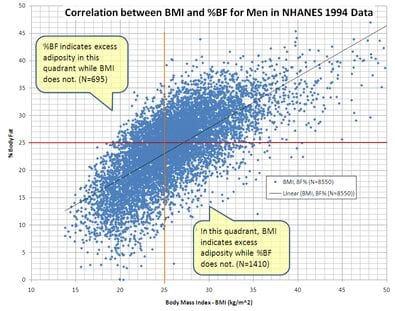Body mass index is the most common indicator of a person’s height to weight ratio. This indicator was first proposed by Adolphe Quetelet in Belgium in the middle of the 19th century.
Calculation scheme: the weight of a person in kilograms is divided by the square of the height in meters. Depending on the value obtained, a conclusion is made about the presence of nutritional problems.
At present, the following gradation according to the range of possible values for the calculated indicator is considered generally accepted body mass index.
- Acute underweight: less than 15
- Underweight: 15 to 20 (18,5)
- Normal body weight: 20 (18,5) to 25 (27)
- Above normal body weight: over 25 (27)
In parentheses are the data obtained from the latest research. Regarding the generally accepted gradation, there is no consensus on the lower limit of the BMI range. According to foreign statistical studies, it has been established that outside the body mass index values 18,5 – 25 kg / mXNUMX2 the relative number of diseases hazardous to health (such as oncological diseases, strokes, heart attacks, etc.) increases sharply in comparison with neighboring values. The same remark applies to the upper bound.
According to the generally accepted division, the upper limit of the normal weight range is determined at a value of 25 kg / m2… Recent research data, presented on mignews.com, raise the upper limit of the normal body mass index to a value of 27 kg / m2 (hereinafter direct quotation):
“In all Western countries, overweight has long been dubbed the disease of the 21st century. Campaigns to tackle the disease are costly and in America, where obesity rates are higher than in other countries, tackling the problem is considered the number one national challenge. Meanwhile, Israeli scientists have come to the conclusion that extra pounds (within reason) not only do not harm health, but also prolong life.
As you know, in the West, it is customary to estimate weight in terms of BMI. To do this, you need to divide your weight by your height squared. For example, for a 90-kilogram person with a height of 1.85 meters, the BMI is 26,3.
A recent study by Jerusalem’s Adassa Hospital in conjunction with the American Institutes of Health found that while BMI levels of 25-27 are already considered a sign of extra pounds, those with a BMI live longer than those who are under normal weight.
Since 1963, scientists have monitored the medical performance of 10.232 Israeli men in various “weight classes.” As it turned out, 48% of people whose BMI was in the range from 25 to 27 “crossed” the 80-year mark, and 26% lived to be 85 years old. These figures are even better than those who follow a normal weight through diets and an athletic lifestyle.
Among those whose BMI level was higher (from 27 to 30), 80% of men survived to 45 years, to 85 – 23%.
However, Israeli and American doctors continue to insist that individuals with a BMI above 30 are at risk. It is in this category that the mortality rate is highest. “
A source: http://www.mignews.com/news/health/world/040107_121451_01753.html
Here it is necessary to make a reservation that this study refers only for men… But the selection of weight loss diets in the calculator, the weight limit according to this new dietary study is included as one of the calculated parameters.










